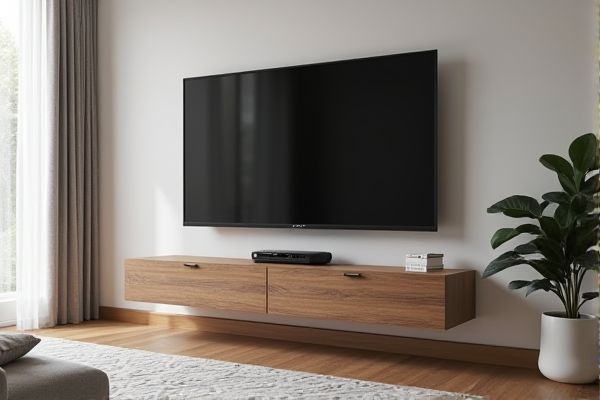
Floating TV stands save floor space and create a modern, minimalist look by mounting directly to the wall, making them ideal for smaller rooms. Explore the rest of the article to understand which TV stand suits your living space and style preferences best.
Table of Comparison
| Feature | Floating TV Stand | Anchored TV Stand |
|---|---|---|
| Installation | Wall-mounted, requires secure anchors | Floor-based, secured with wall anchors or supports |
| Space Saving | Maximizes floor space, perfect for small rooms | Requires floor space, bulkier footprint |
| Stability | Highly stable when properly anchored to wall studs | Very stable, designed to prevent tipping |
| Aesthetic | Modern, sleek, minimalistic look | Traditional, functional design |
| Weight Capacity | Varies; limited by wall mounting hardware | Generally supports heavier TVs and equipment |
| Cable Management | Built-in cable hiding for clean look | Exposed cables or additional cable solutions needed |
| Accessibility | Easier to clean under and around | May obstruct floor cleaning |
Introduction: Floating vs Anchored TV Stands
Floating TV stands create a sleek, modern look by mounting your TV and storage off the floor, maximizing space and making cleaning easier. Anchored TV stands offer stability with a solid base and often include extra storage options, ideal for larger TVs or homes with children. Your choice depends on your space, aesthetic preference, and need for functionality.
Design Aesthetics Comparison
Floating TV stands offer a sleek, modern look by elevating the television off the floor, creating an open and airy feel that complements minimalist and contemporary interiors. Anchored TV stands provide a more traditional and grounded appearance, often featuring additional storage options and sturdy construction that blend well with classic or rustic decor. The choice between the two largely depends on the desired visual impact and functional needs within the living space.
Space Utilization and Room Layout
Floating TV stands maximize space utilization by freeing up floor area, allowing for easier cleaning and placement of additional furniture or decor underneath. Anchored TV stands offer stability and storage options but require dedicated floor space that can limit flexible room layouts. Choosing between the two depends on optimizing room flow and balancing storage needs with open space preferences.
Installation Process and Requirements
Floating TV stands require wall mounting using studs or anchors, demanding precise measurements, secure hardware like brackets or screws, and tools such as drills and stud finders for stable support. Anchored TV stands sit on the floor with legs or bases, needing flat surfaces for placement and minimal installation involving assembly of components or shelves. Floating stands often require professional installation due to weight support and wall integrity considerations, while anchored stands are generally DIY-friendly with fewer requirements.
Safety and Stability Considerations
Floating TV stands provide a sleek, modern look but may require secure wall anchoring to ensure optimal safety and prevent tipping, especially in homes with children or pets. Anchored TV stands offer enhanced stability by firmly attaching to walls or floors, reducing the risk of accidents and maintaining structural integrity during movement or impacts. Evaluating the weight capacity and installation quality of both stand types is crucial for maximizing safety and stability in any living space.
Cable Management Solutions
Floating TV stands offer sleek cable management by hiding wires within the wall or behind the stand, creating a clean and clutter-free appearance perfect for modern living spaces. Anchored TV stands typically include built-in channels or back panels to organize cables, providing easy access and preventing tangling without wall modification. Choosing the right stand depends on your preference for seamless aesthetics or straightforward cable accessibility to keep your entertainment area tidy.
Storage Options and Functionality
Floating TV stands offer sleek storage solutions with open shelving or hidden compartments, maximizing floor space and providing a modern aesthetic. Anchored TV stands typically include more substantial cabinetry, multiple drawers, and shelves that accommodate larger components and extensive media collections. Your choice depends on whether you prioritize minimalist design with moderate storage or a robust, multifunctional setup with ample capacity.
Maintenance and Cleaning Ease
A floating TV stand offers easier cleaning access underneath and around it, reducing dust buildup with minimal effort compared to an anchored TV stand firmly attached to walls or cabinets. Anchored stands may require more maintenance to keep wall fixtures secure and clean hard-to-reach corners where dust and debris accumulate. Your choice impacts how quickly and efficiently you can maintain a dust-free entertainment area.
Cost and Budget Factors
Floating TV stands generally cost more due to their installation requirements and sleek design, often necessitating professional mounting that adds to the budget. Anchored TV stands typically offer more affordable options with simpler setup, making them suitable for tighter budgets or those who prefer DIY assembly. Your choice between these options should consider not only the upfront price but also potential installation expenses and long-term durability.
Which TV Stand is Right for You?
Choosing between a floating TV stand and an anchored TV stand depends on your space and style preferences. Floating TV stands save floor space, offer a modern look, and are ideal if you want a clean, airy environment. Anchored TV stands provide stability, storage options, and are better suited for heavier TVs or homes with kids where safety is a concern.
 homyna.com
homyna.com